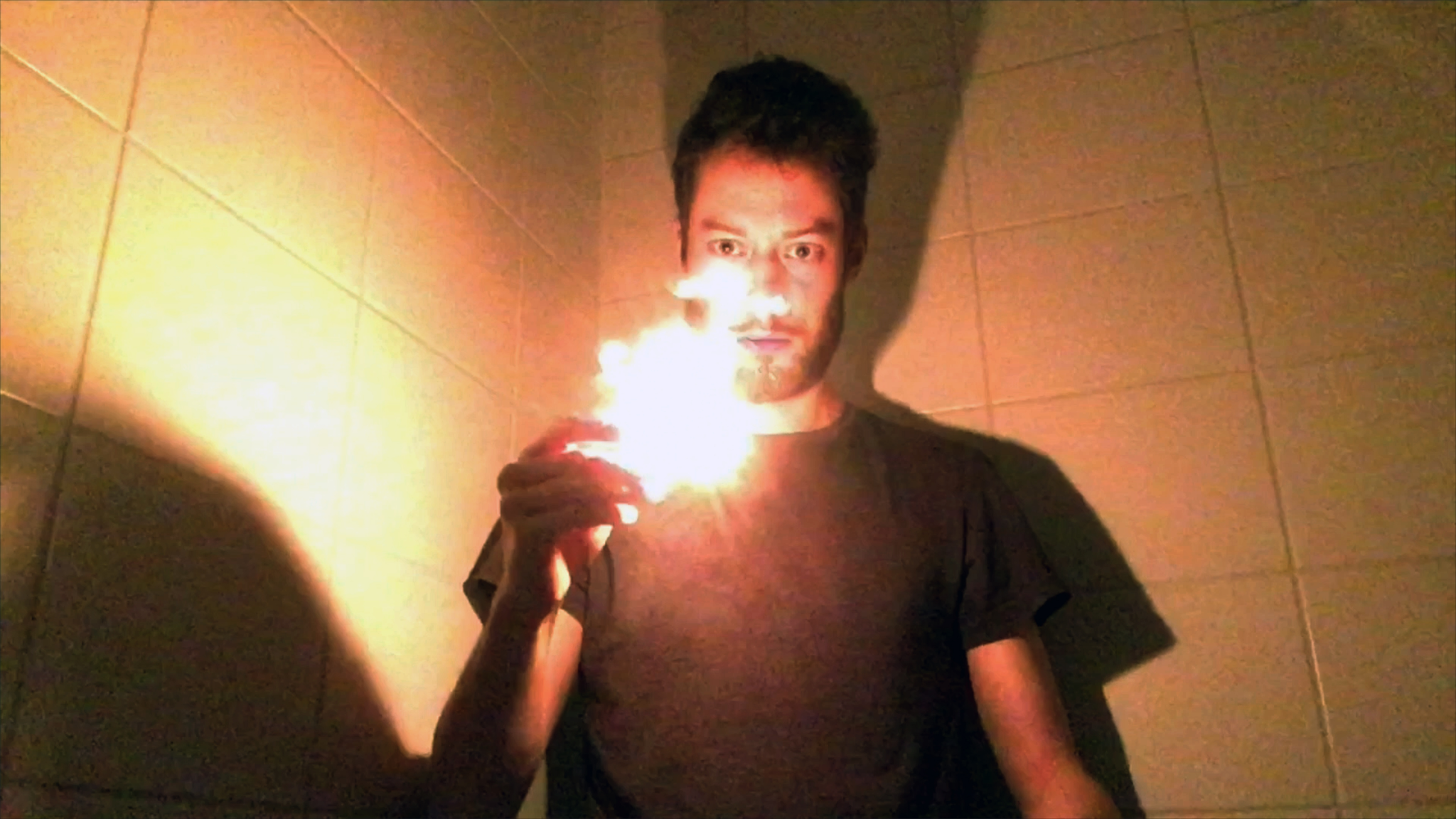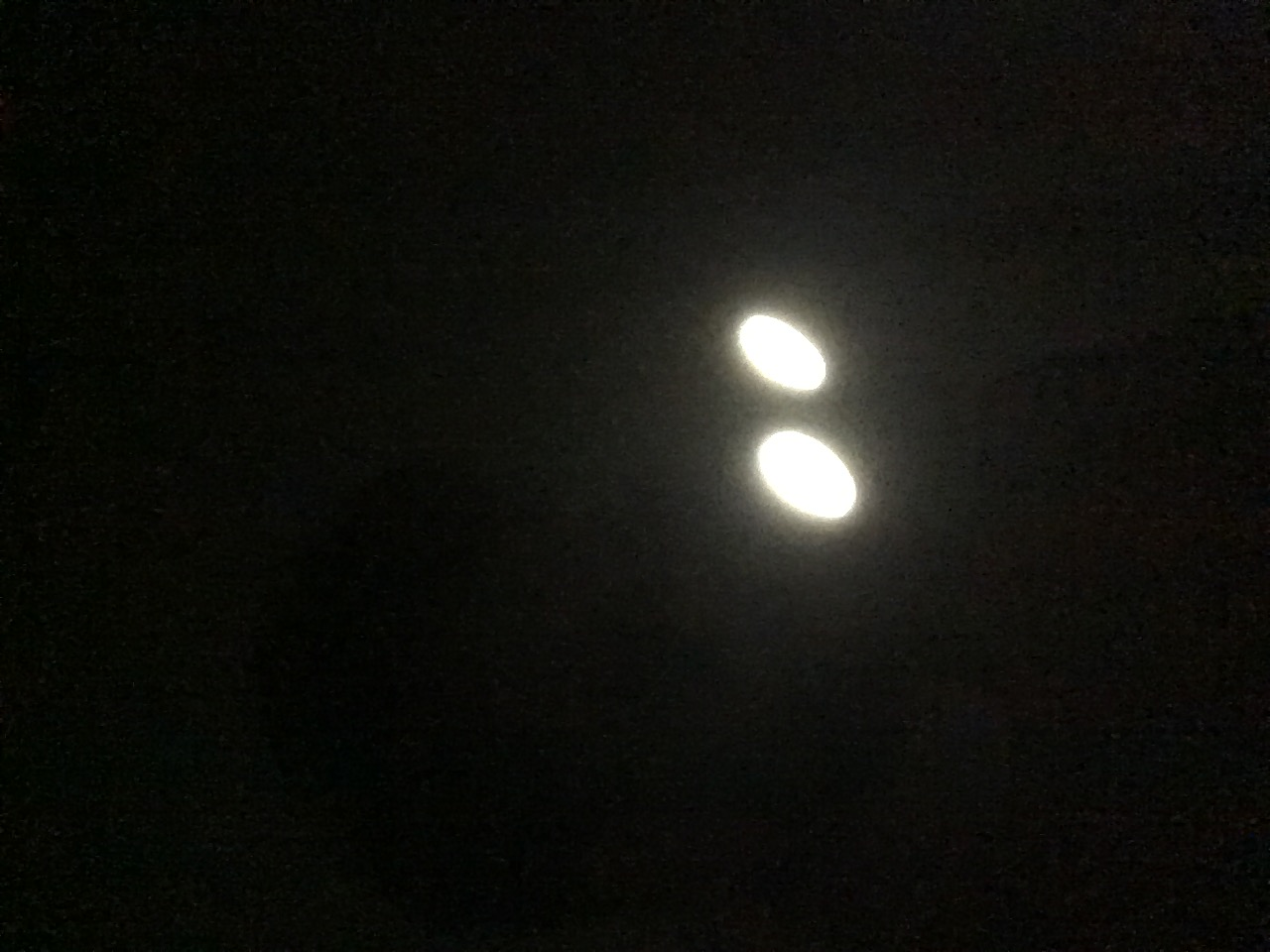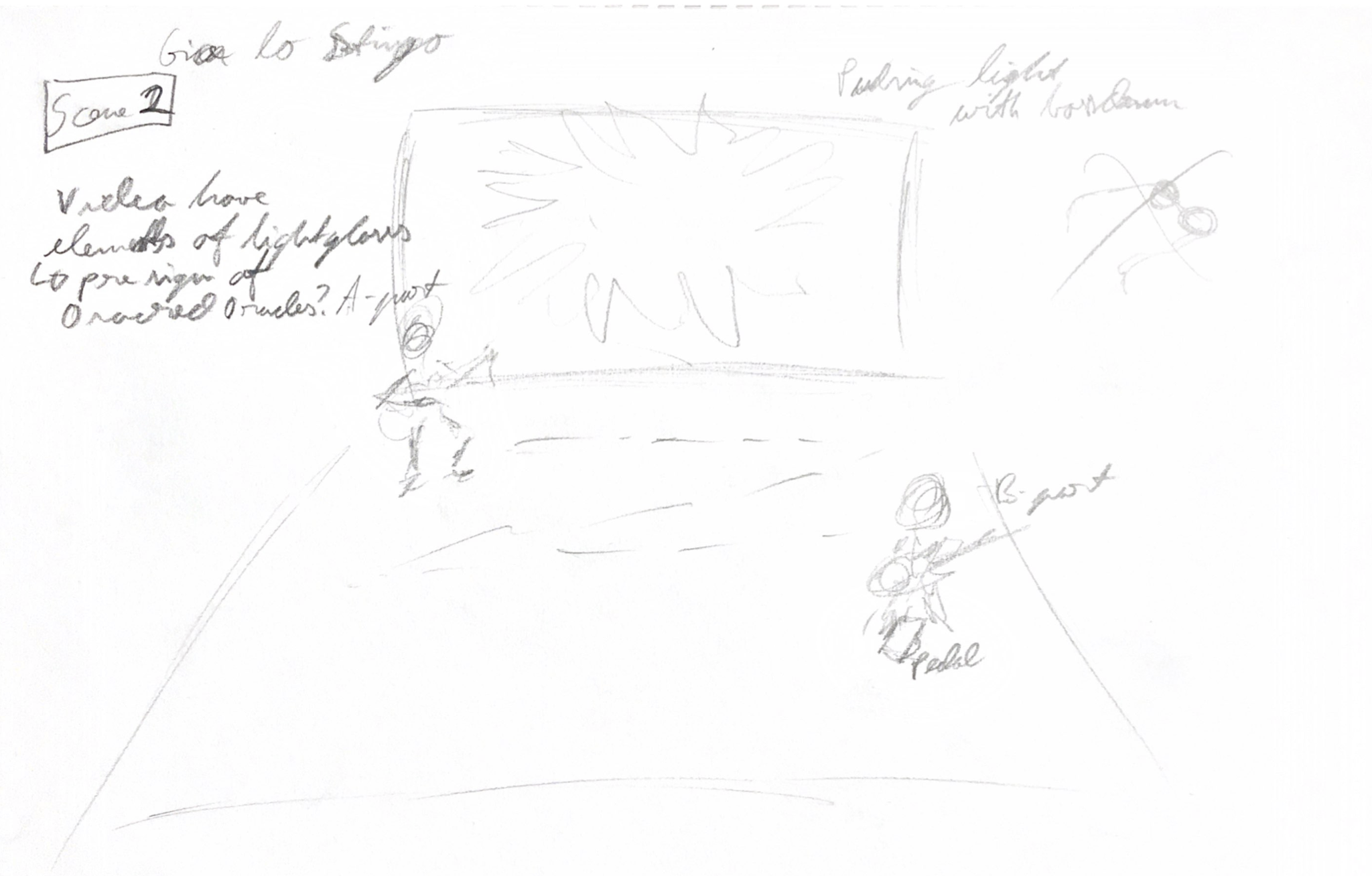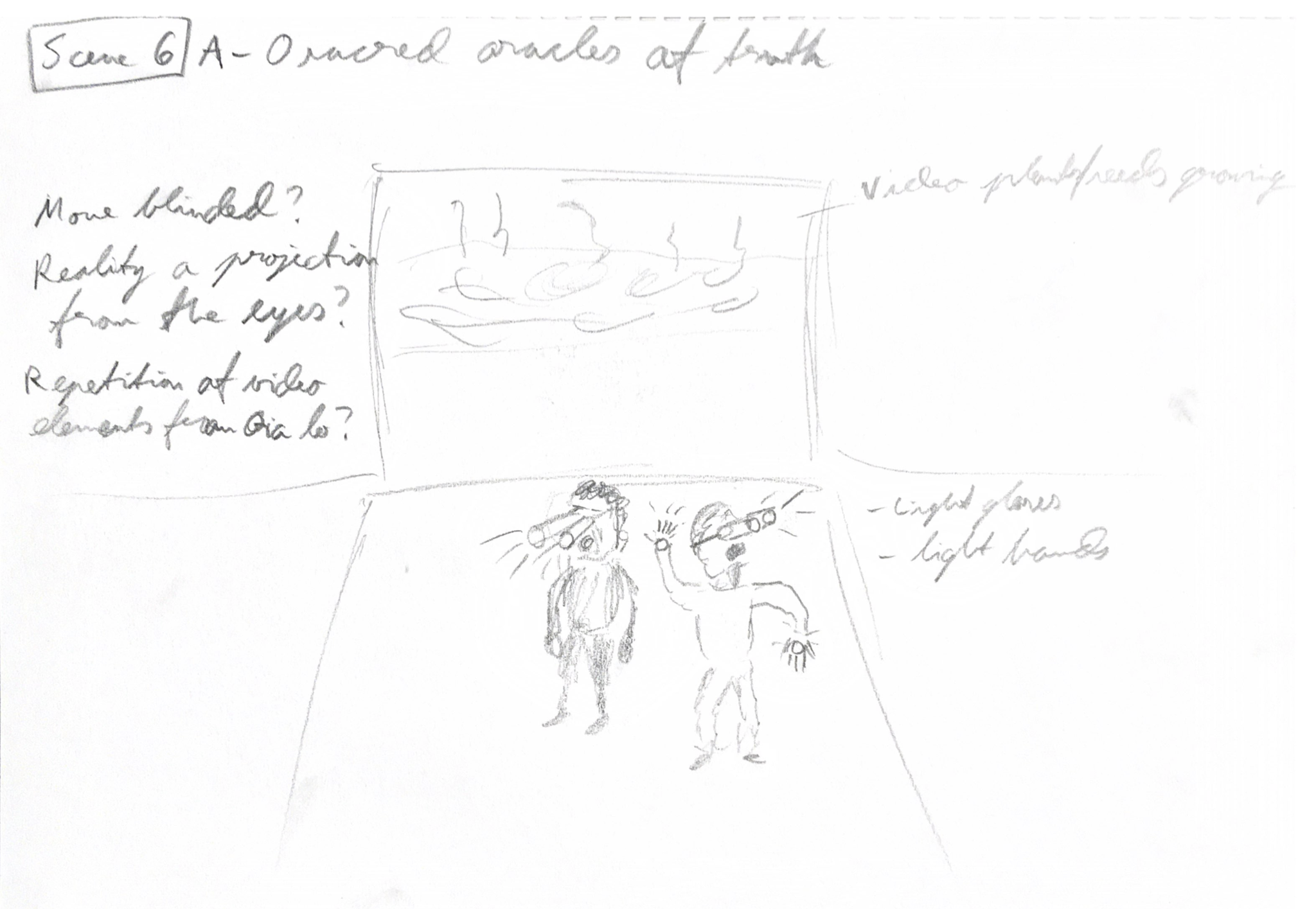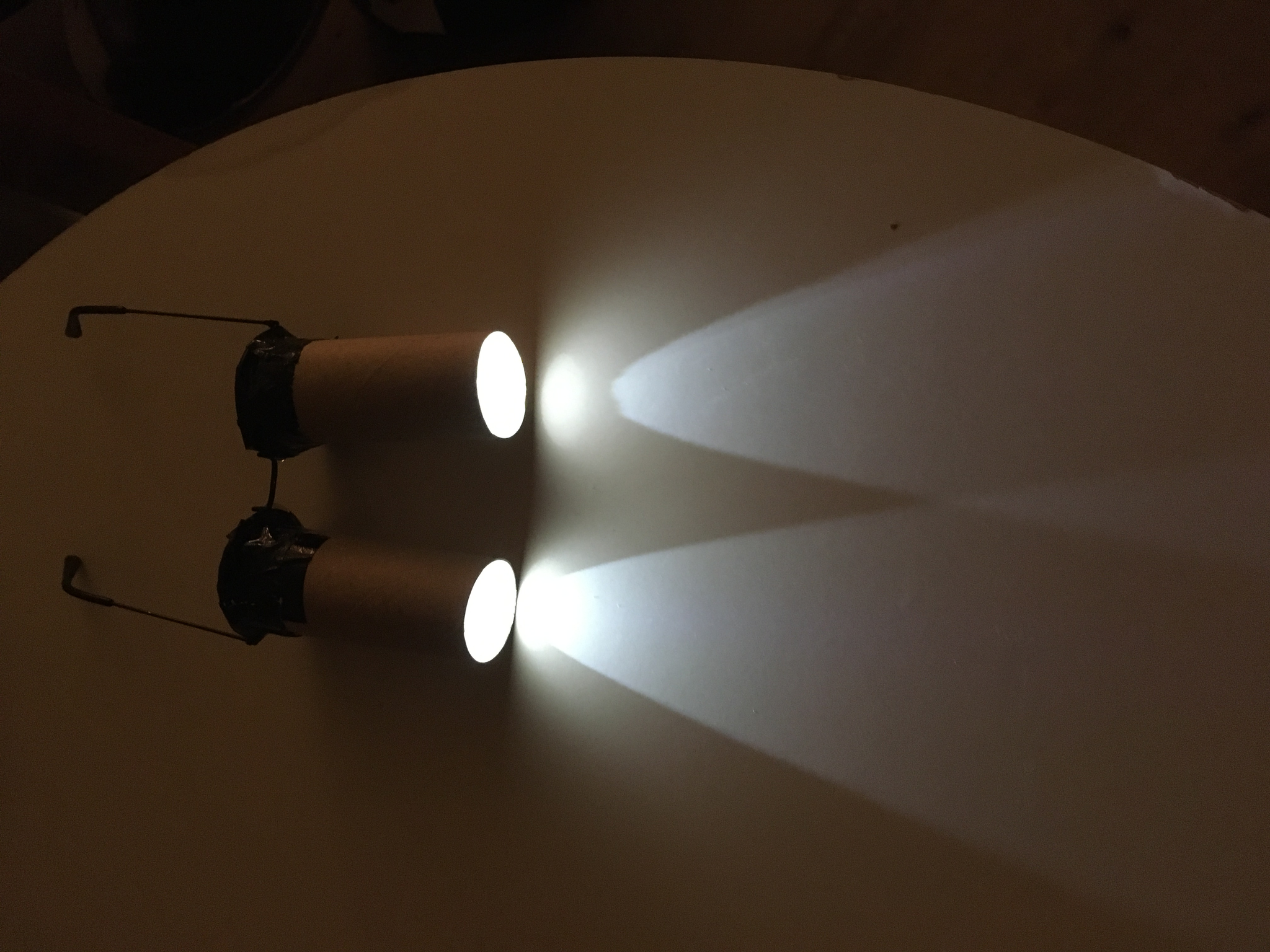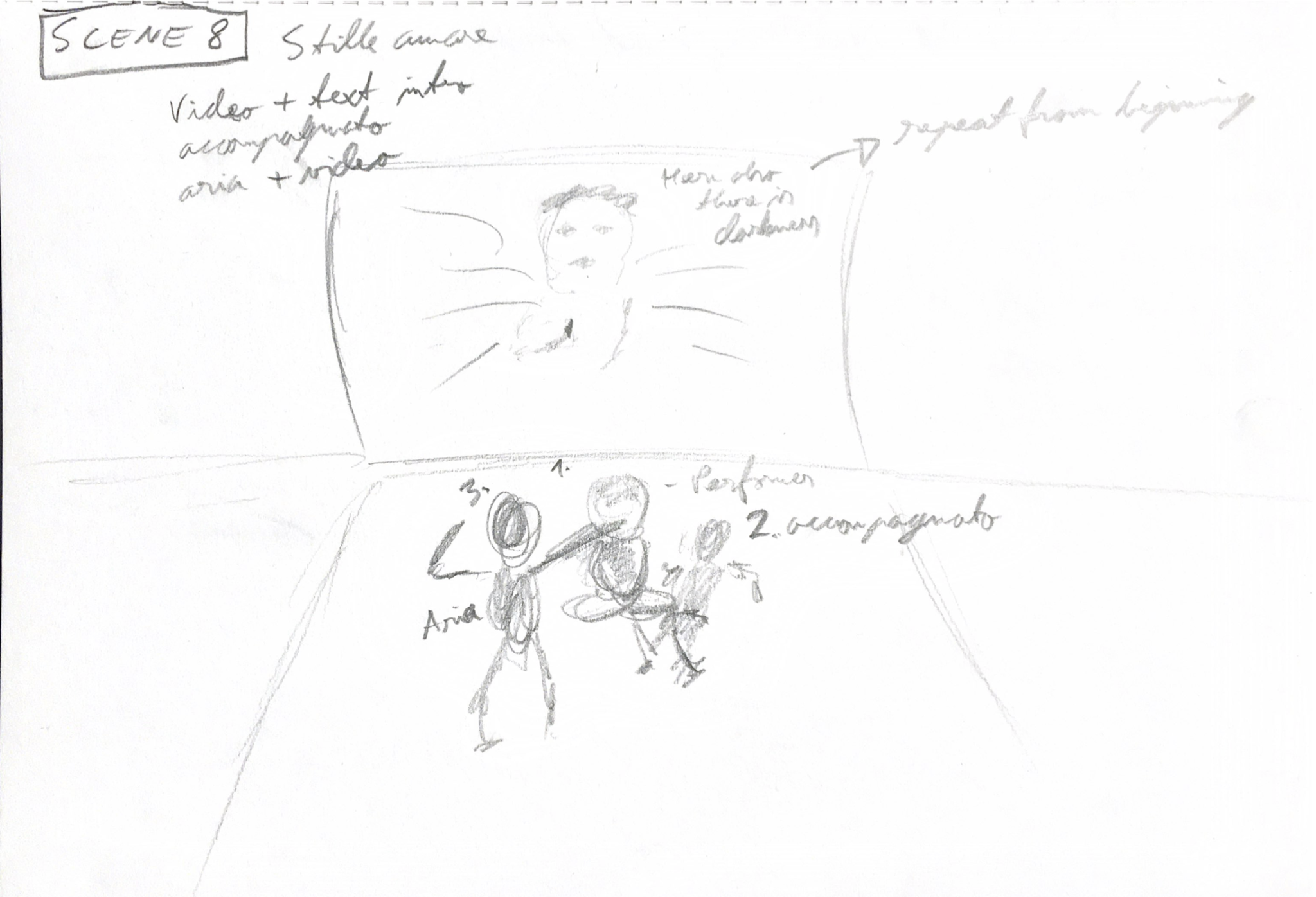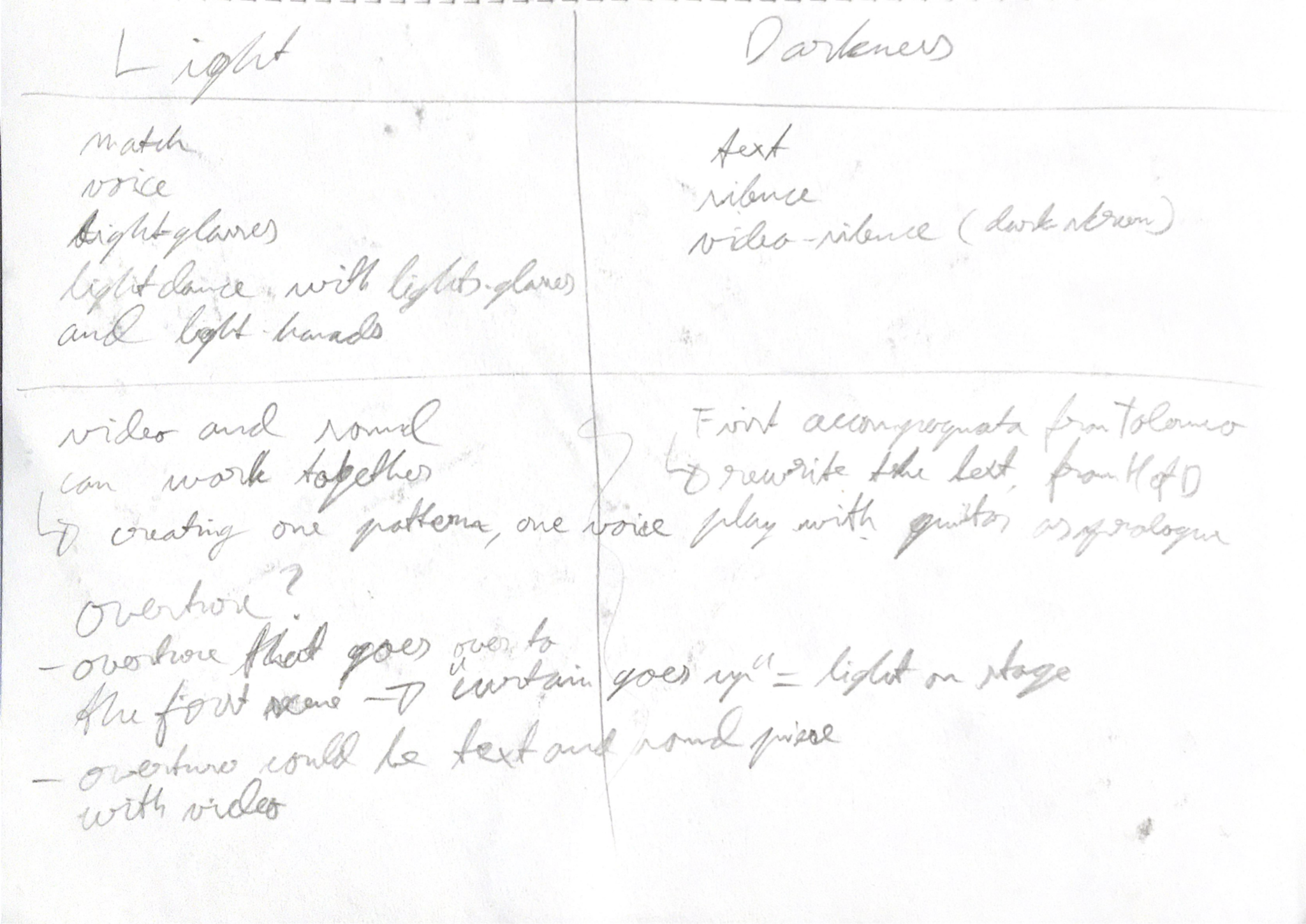Reflection on idea
As I described in the Introduction, the idea for my master project grew out of a series of earlier works and projects. For my artistic development and identity, the idea of creating a project for stage felt like a necessary step towards my goals as performer and creator.
The first idea came from the question: what happens if I place music by Handel in a different thematic context? This led me to the book Heart of Darkness, and its thematic content and mood (see chapter on ‘why Heart of Darkness’). It soon became clear to me that in order to explore the styles and artistic ideas I wished to follow, I had to depart from the story and narrative of Heart of Darkness. Instead, I would use it as a source of thematic inspiration. This way I stood much freer to use and interpret it in the way I wanted and needed for the creation of my project. As mentioned in the chapter on the book, it was not the story that drew me in and inspired me, it was the mood, the images and the darkness that did.
I wanted to explore different medias and combinations of these. Through other projects (as described in the Introduction) I had worked on rearranging and reimagining early music in modern music styles and with electronics and sound production. The same type of work would be central to this project as well; but I had experience of how I could and liked working in this way, and this helped shape my ideas. A central project to draw inspiration and experience from was The John Download Project, that I had worked on prior and during this project. Because of their closeness in time, these heavily influenced each other and served my artistic development in similar manners. As mentioned, the main difference from The John Download Project to this master’s project is that it’s a live piece for stage. I had to expand my way of working and thinking to also incorporate visual and physical elements.
For operatic music, this is not such a strange idea, as the music is originally written for the stage. As a singer, working and reflecting on stage presence and the physical delivery of the music and its story, is far from an alien concept. This is because we often work with operatic music, and we therefore must reflect on the development of a character and the portrayal of the drama. But the bigger tasks of imagining and constructing a concept and style for the staged performance, is something handled by directors, usually in collaboration with a scenographer.
For Handel’s operas there is the challenge of historical performance. As highlighted in the chapter about Handel’s music, there is a challenge with the form of the operas for modern audiences. They are long, and the stories boarder on absurd in their simplicity. They are written for a specific time, when they served a distinct purpose in society, and are constructed to serve these demands. But I discovered that I could turn this around, using it as a source of inspiration. I would let the style of the music and the purpose it served in its original setting inform my artistic choices: either by contrasting, commenting or translating what it could represent. This way I could use the historical aspects of the music and its style to inform and inspire my work.
It became clear to me quite early that I could not use any of the material from the narratives presented in the libretto. It would get in the way of the artistic ideas I wished to explore, but I didn’t want to give up on Handel. I needed a completely different starting point, and I needed to do this in order to stand completely free in my expressive choices. I chose therefore to approach the live stage situation in the same manner as I had done with rearranging the music: by experimenting with the combination of styles. This way I could explore how the music worked in a completely different context, both musically and performatively.
As presented in the chapter on opera and performance art, there are several ways to create operatic works. I decided I could be as free as I wanted with the music and the material. I would create a piece in the manner Nina Penner would refer to as The Ingredients-model: a work in itself, which was not based on a single pre-existing work. Instead, I could use my choices of music by Handel as building blocks. I could treat these arias and recitatives as elements consisting of music, text, emotion and character. I could then decide how true I wanted to stay to these smaller parts or change them completely. I could discover new sides to the material by putting an aria in a completely different context. How would the emotion change? What happens if I change the text? What qualities in the music could be enhanced and explored through the way it is arranged and performed?
In the same way I had explored the material through re-arrangements in The John Download Project, I could now extend the process to the stage by experimenting with light, sound, movement, song and music.
Inspired by director Heiner Goebbels’ idea of reducing the protagonist’s role on stage and departure from narrative driven stage art, I would create a work without a role or story. It would be much more of a collage of stage elements. The different parts would be sewed delicately together by my newly discovered expression poetic logic (see chapter about opera and performance art).
Performance art is something I have been interested in for some time. It is an artform that has inspired me both as a singer and creator. The stylistic elements I wished to explore were closer to this artform, than traditional theatre and opera. It became clear that I should follow this interest and draw more inspiration and reference from this artform and style.
I had now broken it down to some basic elements: I wanted to explore the music by rearranging it and creating a performance piece or situation around it on stage. I also wanted to explore how I could combine styles and references. This way I had focused the work on how I could combine my two sides as a performer: the early music singer with the contemporary performance creator.
Reflection on process
In the drama 4 project (described in the Introduction), and through earlier performance art projects, I had grown to like working not from a fixed narrative but building the piece with different collages and experiments. This process requires in my experience, a strong trust in creative intuition. This is because the process takes time and will not immediately produce fruits. It is a way of looking at the relation between the process and the product, letting the one guide the other. Going on the floor, trying something out, adjusting, reshaping, continuing or starting over. I work this way in most of my projects, but also in other collaborative projects with composers and directors. It’s a style of working that bridges performance art and theatre. For me, this is a preferred way of working within several performative artforms. Regarding music, it may be a bit fresher as this art form has traditionally been focused on the product and not the process. Through the last century we have seen a move from focusing on the piece, the written music (product), to the act of performing the piece (process). As Nicholas Cook points out in his article “Between process and product: Music and/as Performance”1 there has been a shift from product focus to process focus in musicology in the last decades. As a reaction to the traditional view of the composer as the artist, the written piece of music as the work and the performer as merely the messenger; we see a growth of musicologists challenging this by incorporating other factors around the creation of music in their writing. Like social and economic structures, and what the events of music production and performance can signify. This is something I have embraced in my process.
Stille Amare
As described in the Introduction about method, I started by gathering material in different ways. I started with selecting arias by Handel, both from oratorios, cantatas and operas, with features that intrigued me. These were structural elements, such as short or long recitatives and accompagnatos, or emotional characteristics in the arias. As mentioned, I would treat these as building blocks consisting of music, text, emotion, character and expression.
The first piece I started working with was Tolomeo’s aria Stille Amare from Handel’s opera Tolomeo, re d'Egitto (1728), and the preceding recitativo accompagnato Innomano Fratel.
In the John Download project, I had worked within a pop-record format. A major part of the arrangements had been shaped by the style of production. This way I had been able to explore different styles of pop-music and instrument combinations, creating different moods and sound worlds for each song. From this I had gathered valuable experience and a feel for how I wanted to shape my arrangements. I had developed my own production style in a way and been inspired to further this work. I started therefore to arrange the aria and accompagnato in a similar way.
My departure point was somewhere between a sound/mood idea and an idea for the instrumentation. I was directly inspired by the song Go Slowly by the band Radiohead. It has a layering of instruments with different timbres, some electronic and some acoustic, that change from doubling each other and going against each other, creating a special backdrop on which the song can move. I wanted to colour the Handel aria in a similar way. I experimented with finding a similar way to combine electronic and acoustic instruments but with an early music touch. The acoustic instruments I used were therefore baroque guitar and a spinet. I then combined these with both analogue and software synths, creating just the sound world I was seeking. For the recitativo accompagnato I regrouped the instruments, using them in different ways to create variation and highlight the dramaturgical changes in the different parts. To get the phrasing and tempo right, I made a guide-track recording with just harpsichord and voice. This way I had something to build the arrangement around and avoid the fixed tempo and click in the software’s sequencer.
Since I was inspired by the mood in the text in Heart of Darkness and wanted to explore this in my project, I decided to use specific parts of the text and explore how these could work performed over a soundscape. I picked a passage that complimented the aria: the description of Kurts’s (one of the main characters) death. This mirrored the aria perfectly since it is sung right before Tolomeo (the character) “dies”, after thinking he has drunk poison. In the opera it turns out that it was not poison and Tolomeo wakes up confused.2 By marrying this with Kurts’ death I wanted to add a different depth to the music and performance. To compliment the text, I created an unrestful soundtrack with evermoving, half concealed sounds.
To experiment with movement and performative elements, I did a series of improvisations in front of a camera. I wanted to explore video elements more and started to edit and arrange the footages to the soundtrack I had created. I cut out specific actions and parts from the video and composed it around the dramatic curve of the text and the soundtrack.
For the aria I gave myself a short amount of time in a room to experiment with different ideas for the performance of the piece. I filmed it working on the recitativo and the aria separate. In the end I had a video version of me performing the piece while performing movements based on the elements I had experimented with for the earlier soundtrack part. By combining the two parts, the soundtrack with the text and the recitativo and aria with movements, I had a ten-minute video piece that included all the elements I wished to explore. This was a great milestone for my creative process as it gave me something concrete that could help me dictate the further developments. Here I had ten minutes of performance that could be further explored, contrasted and commented. Technically I had developed a method, which was a continuation of the method used in The John Download project. I felt confident that this method would work as a template for the rest of the project.
Master one exam concert
My next milestone was to make a longer part, consisting of several arias or pieces, that I could present on my Master 1 exam concert. I decided to make approximately half the concert (which had to be 50 minutes of music in total) a showcase for my project. Ten minutes of this would be my version of Stille Amare, now developed from video to live stage. For this I decided to keep some of the video material during the aria as an element commenting and mirroring what would happen live on stage.
I had chosen the following material by Handel for my first version of the project: O sacred oracles of truth (aria), Rejoice my countrymen (recitative) and Thus saith the Lord (arioso) from the oratorio Belshazzar (1744), and Fammi combattere (aria) from the opera Orlando (1733). I arranged these using the same method as with Stille Amare: first creating a guide track, then building the arrangement by compiling different instrument combinations. The original character and structure of the piece would inform and inspire my ideas and choices:
In O sacred oracles of truth (aria) the full string accompaniment was substituted with vocoder choir, creating the same full and floating character but with an otherworldly robotic sound. For this I rearranged the text so the vocoder accompaniment could follow the main vocal line. In the intro, before the vocal line starts, I used a passage from Heart of Darkness that added another more eery colour to the expression.
For Rejoice my countrymen (recitative) and Thus saith the Lord (arioso) I based my arrangement on my newly built electric baroque guitar (presentation of the electric baroque guitar) to try and emphasise the explosiveness of the music. I wanted to highlight the sudden changes, the different parts and the powerful preaching character.
For these three pieces I assembled a video of seeds growing. This was inspired by the role plants and jungle have in Heart of Darkness. In the book, nature is something weird, threatening and impenetrable. It has a maddening effect on the European colonizers and represents something unknown and mythical throughout the book. I kept my video in black and white to mirror the eery quality in my arrangements, inspired by the jungle’s description in the book.
I decided to place Fammi combattere last in my miniature. I wanted to challenge myself by approaching this aria in a slightly different way. Instead of building an arrangement by creating a pre-recorded track, I decided to base it on me accompanying myself on the electric baroque guitar. I then created an experimental drum track to work with the guitar playing. I wanted to explore how I could involve the video in another way: by filming myself “performing” the aria and having the live playing and singing as an accompaniment to the video. I started experimenting in front of the camera and soon found out that I wanted to go for a more abstract and emotional expression. Though the aria expresses agitation and power, I interpreted that there is also an inner conflict going on. The character Orlando is convincing himself of the decision to go back to being a knight by saying: “prepare me for battle.” I wanted to bring his sense of doubt with me, letting my interpretation become more and more confident through the aria. I searched to create this by making a video that showed both doubt and fear as well as anger and conviction. This contrast would be emphasised by the contrast between the subtle expression in the video and the explosive live performance of the aria with guitar.
After the exam concert I was left with several interesting questions, both from my own experience and through the feedback from my teachers and others. I was happy with the overall concept, my ideas and the style in which I presented it. The videos and soundtracks all worked well, except Fammi Combattere which seemed fresh and under developed. There were things here that didn’t work so well with the balance between the track and the guitar. As the track only consisted of a scratchy rhythmical synth sound plus some bass, the guitar (played live) seemed rather alone and had to carry the whole harmonic structure of the piece. I would have to add something.
In the first half of my exam concert, I had presented the music in a more traditional way: in a normal concert setting with early music instruments. Without really having thought about it this created an interesting contrast between the two parts. By doing this I managed to highlight how my master project contrasts and differs from a more normal way of presenting early music. There was also a clear contrast in instrumentation: live acoustic wooden period instruments versus pre-recorded electric synths and processed instruments. Because of the way the whole of the concert worked, the idea that became emphasised in my master project part was this contrast and how this worked as a comment to the early music field in general. I felt that this part of my project was now taking too much space. It was becoming the main topic or point to my work. So how could I then incorporate this idea better in my project without it taking too much space?
Tineke Steenbrink, my teacher and coach, suggested bringing these two worlds together somehow. She pointed out how I now presented them as opposites, but that they didn’t necessarily have to exist beside each other. They could be combined so that they show both the contrasts, maybe in an even clearer way, and the similarities at the same time. This was a very interesting idea that I decided I had to experiment with. I had done something similar in my arrangement of Stille Amare. Here I had recorded some baroque guitar and harpsichord, but it was still part of the processed and pre-recorded world. I would need to invite the instruments into a live situation.
Another vital reflection after my exam concert was how my live performing related to the video. Now that I had established the form of singer performing in front of a video as a backdrop or commenting colour, it was time to break it. How could I explore this further? I had tried to change this around in Fammi Combattere by trying to make the video the performer and the live singer the accompanist, but it was not clear enough. I needed to go further and explore more options. By introducing more instruments live I thought this would bring in other possibilities and balance between the pre-recorded elements (video and soundtrack) and live performing elements (instruments, singer and movements). My movements in relation to the video was also a field that was not explored to the fullest. Especially the parts in Stille Amare where I mirrored myself with the video showed potential for further exploration. These reflections became vital for how I continued the development of my concept.
Høstutstillingen 2021
In October 2021 I was selected to be part of Høstutstillingen: the Norwegian state’s annual exhibition. I had submitted my version of Stille Amare as a performance piece and it was selected. Doing this as a standalone performance was very inspiring. It was possible to work on the placement of the video in relation to the stage, and work with lighting which enhanced the qualities in the video. The room was completely dark in the first part, giving all the focus to the video. This created a strong mood and gave new quality to the material. The experience left me with a great trust in the project. I was convinced that the main elements of this part should be the focus of the whole project: these were the basic components performer/singer, soundtrack and video.
I got feedback and comments about certain parts of the combination of these elements that resonated with what I originally wanted to explore. The duality of the video and performer was a clear strong point and something I had to further explore. Especially the parts where the video mirrored the actions live. Some commented how this made the video come alive in a special way, making it present in the same way the live performance is present. I found this interesting, understanding that this was something I had to explore further. I experienced that the soundtrack and video worked really well together and created the mood I wished to explore. Looking back on my Master one exam I felt that the other pieces didn’t hold this same mood. There was some drama and feel previously missing that I had managed to catch in the Stille Amare part. The relation between the text from Heart of Darkness and the music by Handel seemed to create something other. This connected well with my original idea for the project. The other songs had other conflicting ideas and might have to be focused in another way.
The idea to bring in live instruments that I got after my Master one exam presented by my coach Tineke, felt now like another performance. After doing Stille Amare again, I found it was crucial that I focus my elements and ideas, so that I could create a good framework.
Another important comment I received after the performance was that through the piece, I managed to convince the audience of the music and its operatic style. This was an interesting point as the audience in this performance was mainly a visual art audience that had come to see the exhibition. I experienced that an audience like this would find operatic singing and the almost melodramatic style of the music very different and almost comical. However, through the combination of the visual and audio elements I managed to create a world where this fiction was accepted. To me, this was a central strong point. My goal for the continuation of the work became to make all the parts of this performance just as strong.
Questions on text
For the performance of Stille Amare I had deliberately not presented what the text meant. In the presentation text I had mentioned how I wanted to leave the original Italian text unexplained or commented as a poetic element that is left unanswered. They would hear a song in a language that they not necessarily would understand, and the questions that this arises in the audience becomes a part of the experience. This left a sense of mystery to the piece, especially in relation to the English text that is presented on the loudspeakers in the beginning.
After the performance I received several questions about the text; what it meant, what the story behind it was and how it related to the piece. I felt that some of these questions came from the curiosity that I wanted to inspire in the audience, but it also drew my attention to how strong a text can be in a piece like this.
The other text on the track has an important role in setting the atmosphere and is the main carrier of the piece in some parts. This was also my idea, but it also shows the potential in the material: the relation between the spoken (pre-recorded) and the sung text (live) could be explored further. What I presented in Stille Amare was one relation. It was also one relation between Handel and Heart of Darkness as material. However, there could be other connections between them.
This led me to the idea to rewrite the text for some of the arias that I was working with. This could be done by writing a new text, reshaping parts from Heart of Darkness to fit a song or translating the Italian libretto to English (same language as Heart of Darkness).
Shaping the final piece
I continued by collecting more repertoire to explore. I was searching for contrasts, moods and characters that could compliment the material I had already developed. My goal was to find material for a c. 50-60 minute performance. With the pieces I had used for the Master one miniature, I had the following list of pieces:
Eternal source of light divine from Ode for the birthday of queen Anne
Già lo stringo, aria from Orlando
Orri de Larve, accompagnato from Admeto re di Tessaglia
Chiudetevi, aria from Admeto re di Tessaglia
Fammi Combattere, aria from Orlando
Vuò dar pace, aria from Tamerlano
O sacred oracles of truth, arioso from Belshazzar
Rejoice my countrymen, accompagnato from Belshazzar
Inumano fratel, accompagnato from Tolomeo, re d’Egitto
Stille Amare, aria from Tolomeo, re d’Egitto
I approached the tracks for the new pieces in the same manner as I had done earlier: creating a guide track and building the arrangement around that. I used some of the same instruments and sounds that I had used to make it easier to connect them and further explore the sonic possibilities that these instruments and sounds offered. Within this frame and method, I looked at possibilities for development, contrasts and change. Inspired by the way Handel worked as a composer, I wanted to look at how I could play with my “style” to create differences and surprises. I wanted to do this by both focusing my work on the elements in use and on how to balance the combinations of these elements.
I also applied this process to the development of the performative elements. Using my ten-minute performance Stille Amare, I looked at the central movements and relations between the different elements. Writing down the key features I started drawing ideas for “scenes”. This helped visualise the different ideas and think about how to explore the scenic space on stage.
Tracing back my work with the video in Stille Amare, I observed that the main visual element I worked with was the contrast between light and dark. I sketched out different parts that represented either light or dark, creating keywords that I could focus on. The light and the dark could mean different things, but it was the contrasts I was interested in. Both the contrasts between elements and their symbolic potential.
Dance
The opening accompagnato and aria from the opera Admeto is preceded by a dance of spirits with bloody knives, as stated in the libretto (and score). It is not sure what this dance could have been,3 but it left me with a vivid imagination as to which effect this must have had being the opening scene after the overture. This inspired me to explore how I could develop a dance part that borrowed steps and movement from baroque dance, merging it with my own performative language of movement. This seemed to be great material to explore the movements I had developed in Stille Amare.
In the book Dance in Handel’s London Operas, Sarah McCleave discusses who could have performed the dance of the spirits, pointing out that because of its theme it most likely was in the style of the grotesque dance, which had its tradition from Italian Commedia dell’arte.4 Inspired by this I got in contact with Teun van Roosmalen, a classically trained dancer, who could assist me in building this dance using the following principle: use the concept of the grotesque dance as an inspiration and departure point for creating my dance.
Acting
As I was exploring ideas for performative elements to explore with the repertoire that I had chosen, I reflected that I now had drawn inspiration from both the historic aspects of the music and dance in Handel’s operas but had done nothing about the acting and the performative aspect of the arias. This led me to adopt the idea I had had for inspiration for dance to the acting. I contacted João Paixão, a researcher in historical acting, presenting my idea and asking for guidance on how to explore it. He advised me to limit my idea by focusing on only some clear concepts in historical acting. By choosing certain dogmas from the tradition, I could then translate this to my own movement language. This way I could more easily connect it visually to the other performative elements I was exploring, and refrain from doing some half-studied attempt at performing historical gestures since it requires time to learn this style fully. This made complete sense to me because it aligned with the way I worked with the arrangements of the music.
The main concept we decided to focus on was the following:
- The gaze – what direction the eyes go in connection with the emotional expression in the text and music.
- Gesture – gestures emphasising specific words in the text.
- Exploring performing the text by speaking it in my counter register.
I now had material for a performance of my desired length, and ideas and concepts for each part or scene. The last part of my work would be to finetune the ideas and work on the development of the whole piece.
